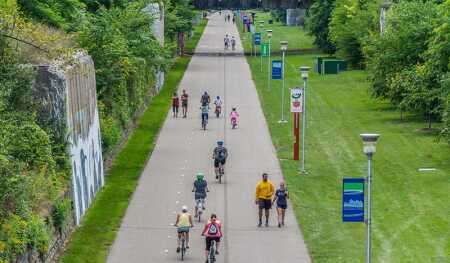
The Dequindre Cut Greenway is an urban recreational path that opened to the public in May 2009. The two-mile (3.2 km) greenway was developed through a public, nonprofit, and private partnership—comprising the federal government, the city of Detroit, the Community Foundation for Southeast Michigan, and the Detroit Economic Growth Corporation—and offers a pedestrian link between the East Riverfront, Eastern Market, and several residential neighborhoods in between. (Detroit Riverfront Conservancy)
Development professionals from Detroit, Houston, Atlanta, and San Antonio discussed how they reclaimed desolate space with art, parks, and public/private partnerships to revitalize riverfronts and neighborhoods.
And, in Houston’s case, with its Buffalo Bayou Park redevelopment, to withstand historic rains and Category 4 Hurricane Harvey.
Demand for parks is growing, especially to transform outdated and dilapidated infrastructure, said Juanita Hardy, ULI senior fellow for creative placemaking. She moderated Wednesday’s session, “Building Triple-Duty Public Spaces: Promoting Resilience, the Arts, and Economic Development.”
Thomas Fish, chairman of the Buffalo Bayou Partnership, said the destination spot was essentially “a drainage ditch and open sewer” for Houston before a $25 million redevelopment commitment from the Kinder Foundation jump-started a public/private partnership transformation. Now, an old underground water cistern has been adapted into a captivating art gallery, and the neighborhood has “become one of the hottest spots for urban development,” said Fish.
Spring Meeting Resources: Download Presentation
The parkway, with 160 acres (65 ha) along 2.3 miles (3.7 km), was designed to be a sustainable and resilient floodway also. In August 2017, Hurricane Harvey dumped 40,000 cubic yards (30,600 cu m) of silt and dirt onto its grounds, and Fish said it cost $1 million to haul it away. But he said Buffalo Bayou’s design—built “bigger, stronger, fatter, and heavier” and 20 percent costlier at the urging of the Kinder Foundation—saved the $60 million project from being destroyed by Harvey.
Mark Wallace, president and CEO of the Detroit Riverfront Conservancy, showcased a stretch of land along the Motor City’s riverfront, once dominated by cement silos and industrial use. When General Motors bought Detroit’s iconic Renaissance Center in 2003, the auto company also bought a $25 million stretch of the riverfront and gave it to the conservancy to be its nonprofit steward.
Now, the riverfront’s RiverWalk draws 3 million visitors a year and has spurred $1 billion in investment nearby. The site hosts 50,000 people for walks and runs, a fishing festival, and riverfront yoga.
Wallace said that corporate, philanthropic, and government partners were united to redevelop “a place you’d never take people to” into “a place where everyone feels welcome.”
Frates Seeligson is the director of Confluence Park in San Antonio, Texas, which opened in March next to the San Antonio River.
It is built on an old industrial yard in a neighborhood where the median income is $25,000 per household. In its first few weeks, already 1,700 students have visited to learn about the area’s ecosystem. A gathering space under lily-like concrete structures is public art, a way to stay in the cooling shade, and a system to catch rain for irrigation.
Confluence Park is “a space that’s aspirational and inspirational,” said Seeligson. “The park was going to be the art. The park was going to be the teaching tool.”
The Atlanta BeltLine, when it is completed, will include trails, park space, and art linking 45 different neighborhoods in Atlanta, said Stacy Patton, its director of real estate and asset management.
The BeltLine’s goal is to build 33 miles (53 km) of trail for cycling, walking, running, and gathering spaces. It will clean up 1,100 acres (445 ha) of degraded land and create 1,300 acres (526 ha) of new parkland. The project incorporates four rail lines, including one still in operation.
“We’ve seen 18,000 housing units come on line since the inception of the BeltLine,” said Patton. Warehouses that had backed up to the route “now want to create new facades and front doors” to the trails.
ULI’s Hardy also brought attention to the movement to make parkland available to more communities, and just a ten-minute walk away for residents. For more info, visit www.uli.org/10minutewalk.
For additional examples of transformative development through parks and open space, sign up for updates on the 10-Minute Walk Campaign or follow #10MinWalk. The 10-Minute Walk Campaign, a national movement led by the Urban Land Institute, the Trust for Public Land, and the National Recreation and Park Association, is promoting the bold idea that everyone living in urban America should live within a 10-minute walk of a park.




